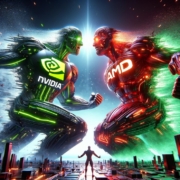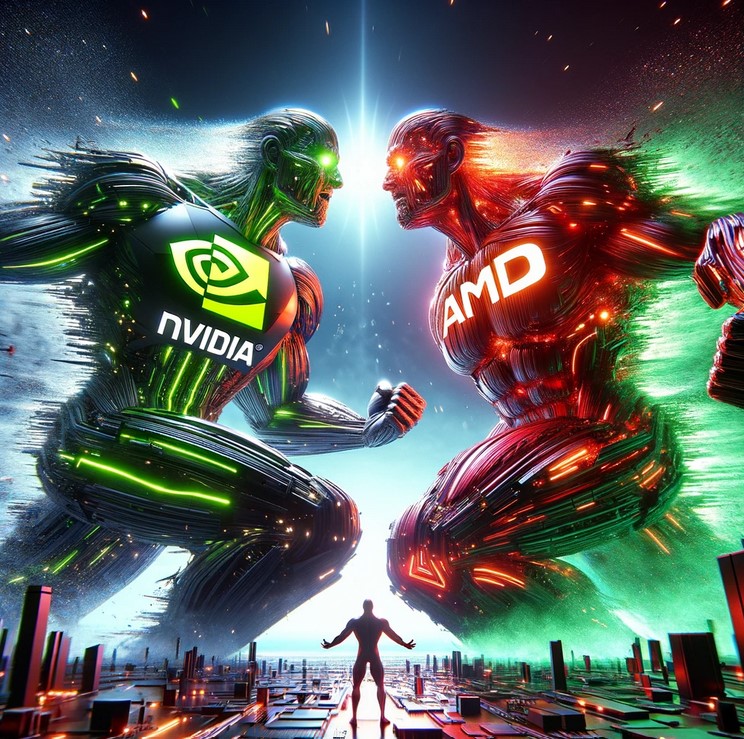(AMD), (MSFT), (AMZN), (GOOGL), (NVDA)
Artificial Intelligence (AI) has surged to the forefront of the technology sector this year, with Microsoft (MSFT) setting the stage through a multi-billion-dollar investment in OpenAI, the innovator behind ChatGPT.
This strategic move has not only captured the attention of the tech world but also set off a chain reaction, prompting other tech giants like Amazon (AMZN) and Alphabet (GOOGL) to invest in similar AI ventures, such as Anthropic. These investments have created a palpable excitement among Wall Street and retail investors, heralding a new era in technology.
However, it was Nvidia (NVDA), a titan in the semiconductor arena, that truly set the AI investment world ablaze.
The company's extraordinary performance in data center services and advancements in graphics processor units (GPUs), as showcased in its May earnings report for Q1 of fiscal 2024, resulted in a dramatic 60% surge in its stock value.
In stark contrast, Advanced Micro Devices (AMD), Nvidia's primary competitor, saw a mere 8% increase in stock value over the same timeframe.
This notable disparity, especially amidst the current enthusiasm for chip stocks and AI technologies, suggests a significant shift in investor focus towards Nvidia, seemingly overshadowing AMD.
However, a closer look at AMD's recent third-quarter earnings report tells a different, more nuanced story.
Contrary to being overshadowed, AMD continues to demonstrate robust operations and presents a compelling case for long-term investment.
Delving into the specifics of the report reveals AMD's strategic positioning to challenge Nvidia's dominance. Additionally, analyzing the company's long-term outlook in relation to its current valuation underscores why it might be an opportune time to invest in AMD.
AMD's performance in the third quarter was solid, with total revenue reaching $5.8 billion, marking a 4% increase year-over-year.
The data center business emerged as a significant revenue driver, generating $1.6 billion in sales. Although this figure hasn’t dramatically changed since last year, recent strategic moves by AMD suggest imminent growth in this sector.
About a month ago, AMD acquired Nod.ai, a machine learning startup, continuing its successful streak in mergers and acquisitions.
This acquisition, alongside the purchase of Mipsology, a startup specializing in "image inference computation," strategically enhances AMD's data center operations.
These acquisitions, integrating seamlessly with AMD's core services, underscore the company's innovative approach and potential for revitalization in its data-center business.
In addition to the data center business, AMD’s client segment also reported remarkable growth.
For the quarter ending in September, AMD recorded a 42% increase in client revenue year over year, amounting to $1.5 billion.
This surge, primarily driven by a stabilizing PC market, signals a significant comeback. The PC industry, despite facing challenges like a 16% drop in shipments in 2022 and continued decline in 2023, saw AMD’s client segment flourish, mirroring the recovering PC market and increasing chip sales.
Looking to the future, AMD’s management has laid out an optimistic forecast for both the data center and client segments.
The company projects “strong double-digit percentage” growth in these areas. Specifically, the data center business is expected to surpass $2 billion in revenue by 2024, bolstered by rapid advancements in AMD's AI roadmap.
The data center AI market, valued at $30 billion, is expected to grow to $150 billion by 2027. AMD's entry into this market, though later than Nvidia, introduces a formidable contender.
Moreover, it has been preparing to launch a new AI GPU in 2024, poised to directly challenge Nvidia’s market dominance.
Despite Nvidia holding an estimated 90% of the AI chip market, AMD's forthcoming MI300 chips – MI300A and MI300X – are set to disrupt the industry. These chips, designed for data centers and AI machine learning, offer competitive advantages in terms of memory bandwidth and computational power.
The MI300X, in particular, is strategically positioned to challenge Nvidia's H100 GPUs, offering substantial memory bandwidth and being well-suited for large language models in AI machine learning.
Microsoft's collaboration with AMD as an AI chip partner further underscores AMD's potential in this rapidly evolving sector.
Moreover, with the GPU market projected to escalate to a staggering US$190 billion by 2028, AMD's new AI accelerators are anticipated to be key drivers of revenue growth.
While Nvidia has undoubtedly experienced a meteoric rise in the AI market, AMD has emerged as a compelling investment alternative. Given its current undervaluation, I suggest you buy the dip.




